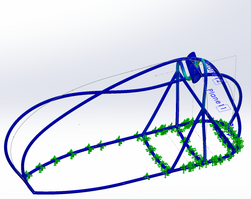FEA: PAL-V Chassis Design
2018. Group project with James Krasucki, Justice Duruanyanwu and Sophie Owen.
Iterative design of a chassis for the PAL-V flying car using Finite Element Analysis to test a static load, cyclic moment and vibration.
FEA • Mechanics • Analysis • CAD • Teamwork • SolidWorks Simulation
This project supported a second year module on Finite Element Analysis (FEA) theory by using FEA in the design process of a chassis for the PAL-V flying car. Designs had to meet a specification including:
- A fundamental frequency above 50 Hz;
- Ability to support the landing force (specified as a static load), and
- Withstand 10 years of use, specified as a cyclic moment related to the rotation of the vehicle’s blades.
I developed several design iterations, as did the other members of our team. We evaluated our best designs, selecting one to take forward for more detailed FEA involving mesh refinement and convergence in areas of highest stress.
Some more complex and seemingly sturdier models would fail in areas with complex or angular geometry where stress concentrators are high. While results would reflect this, sanity checks and closer inspection of the FEA models would reveal that the results would sometimes be exaggerated by various issues, such as very high aspect ratio elements
Simulation Results
Of static load for landing (first image) and cyclic moment from rotor blades about various axes.
Alternative Iterations
Various alternative iterations, many more complex in nature but with worse performance, partly due to stress concentrations near abrupt changes in geometry though results could sometimes be exaggerated due to high aspect ratio elements, as in the final image.








